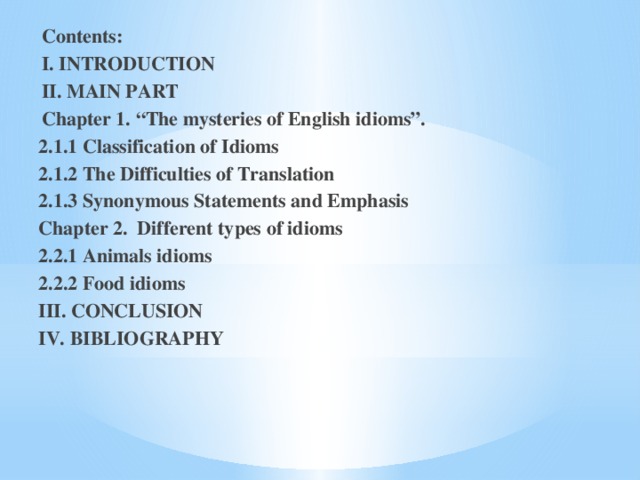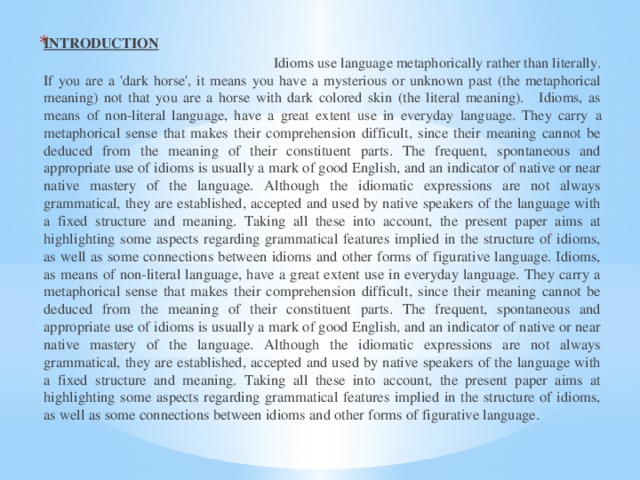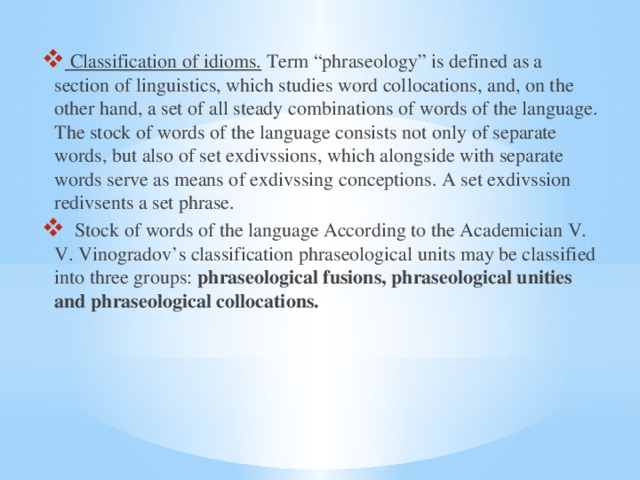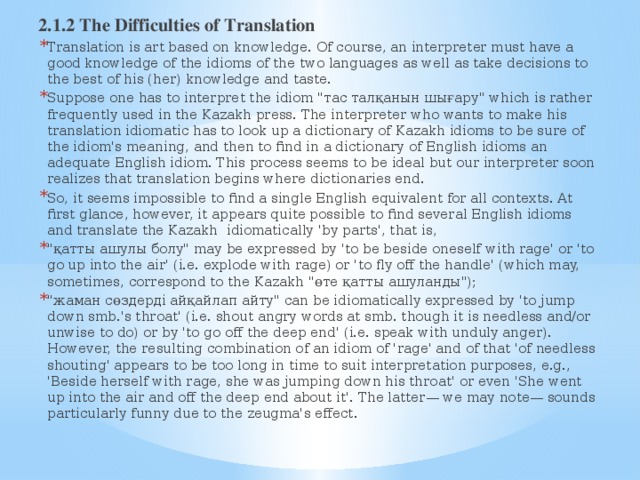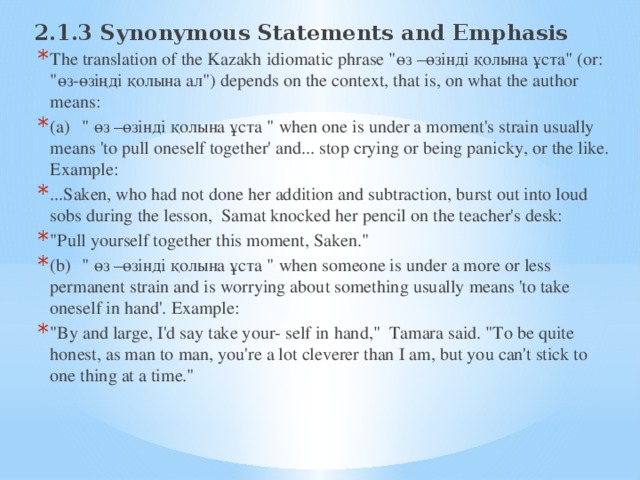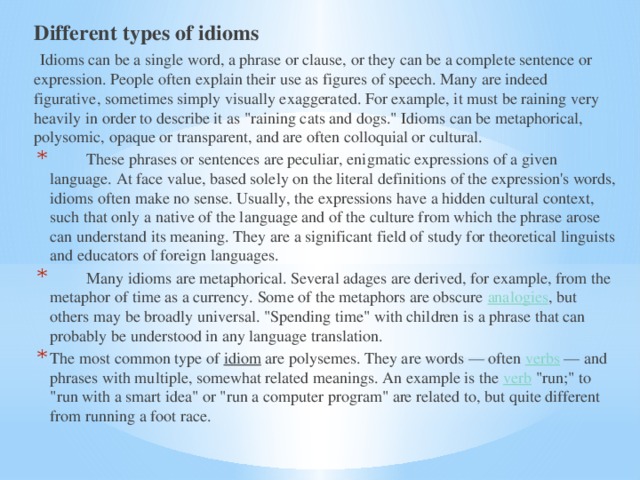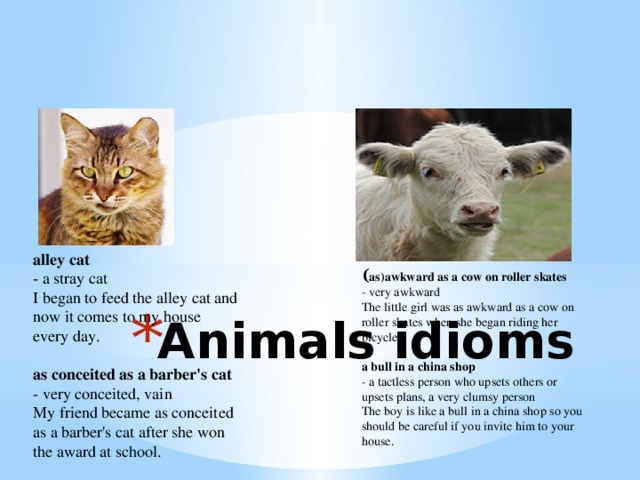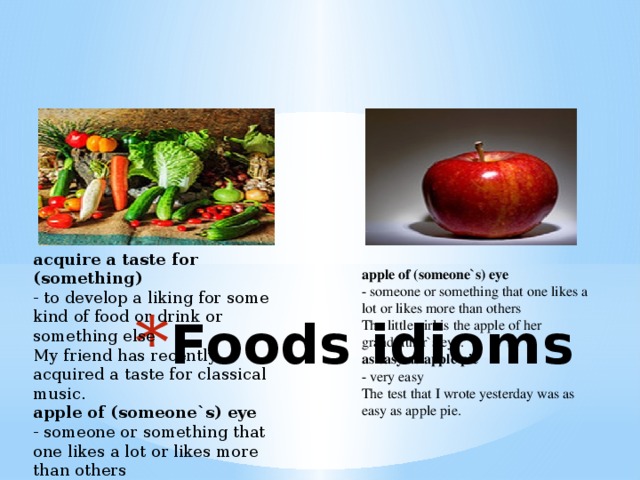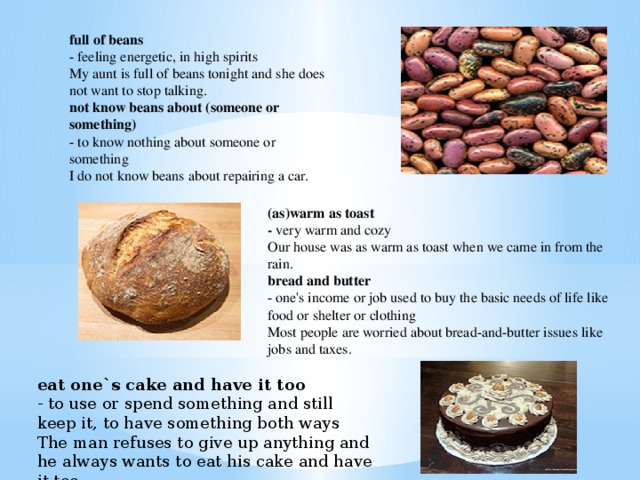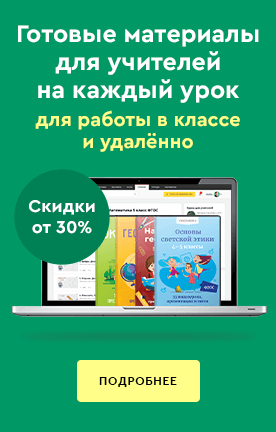Аннотация
В научном работе Динара провела большую по сбору материла, его систематизации, анализы и слайдов. Исследователь приводит свои взгляды и выводы по избранной тематике. Научная работа выходит за рамки школьной программы и расматривает самую актуальную проблему современности – изучение междунородного языка. В этом актуальность и ценность данного научного проекта.
В научной работе на тему «Тайны английских идом»представленной Шахабаевой Динарой на секцию «английский язык» иследователь полностью выполнила поставленную перед собой цель. Научный проект актуален и требует своего продолжения.
Аннотация
Динара «Ағылшын тіліндегі идиома сыры» тақырыбына жазған ғылыми жұмысында материалдарды жинақтау, талдау, арқылы көп жұмыстар атқарған. Зерттеуші таңдап алған тақырыбы бойынша өз көзқарастары мен тұжырымдарын жазған. Ғылыми жұмыс мектеп бағдарламасынан тыс және халықаралық тілді үйретудің қазіргі заманғы ең келелі мәселелерін қарастырған.
Шахабаева Динара ғылыми жобасында өз алдына қойған мақсатын толық орындаған. Ғылыми жоба келешекте жалғасын табатыны сөзсіз.
Abstract
In the scientific work Dinara has made extensive work by collecting the material, its systematization and analysis, slides. The researcher makes her own opinion and input on the selected topic. The scientific work goes beyond the school program and examines the most popular item of our time – learning of international language. That is why this work is popular and valuable.
In the scientific work on the theme «The mysteries of English idioms» presented by Shahabaeva Dinara on the section «English language» researcher has achieved fully set aim. The scientific work is of present interest and demands its continuation.
CONTENTS:
I. INTRODUCTION
II. MAIN PART
Chapter 1. The mysteries of English idioms
2.1.1 Classification of Idioms
2.1.2 The Difficulties of Translation
2.1.3 Synonymous Statements and Emphasis
Chapter 2. Different types of idioms
2.2.1 Animals idioms
2.2.2 Food idioms
III. CONCLUSION
IV. BIBLIOGRAPHY
I. INTRODUCTION
Idioms use language metaphorically rather than literally. If you are a 'dark horse', it means you have a mysterious or unknown past (the metaphorical meaning) not that you are a horse with dark coloured skin (the literal meaning).
Idioms use language metaphorically rather than literally. If you are a 'dark horse', it means you have a mysterious or unknown past (the metaphorical meaning) not that you are a horse with dark coloured skin (the literal meaning).
Idiom is a phrase or expression whose total meaning differs from the meaning of the individual words. For example, to blow one’s top and behind the eight ball are English- language idioms. Idioms come from language and generally cannot be translated literally. Foreign language students must learn them just as they would learn vocabulary words.
It is generally accepted that interpreters did not know much about the laws and rules of translation at the dawn of civilization. They did not have enough scientific knowledge, and some writers maintained later that translation was a problem which could never be solved.
But life went on, and people wanted to communicate (they wanted to be good neighbors in those times, too) and — take it or leave it — they had to interpret and had to translate. But still their translations were not without shortcomings and even left much to be desired.
The objective of the work is an attempt to study all the aspects of idioms, the cases of their usage and to analyze the frequency of idioms usage referring to English and Russian.
To achieve the set aim we determine the following tasks:
to classify idioms;
to study the problem of the translation of idioms;
to understand the aim of the modern usage of idioms;
to distinguish different kinds of idioms;
to analyze the frequency of idioms' usage referring to English and Kazakh.
Theoretical value consists in revealing the fact that idioms can’t and mustn’t be translated directly as such a branch of language as idioms are inseparably connected with nation’s mentality and mode of life.
Idioms, as means of non-literal language, have a great extent use in everyday language. They carry a metaphorical sense that makes their comprehension difficult, since their meaning cannot be deduced from the meaning of their constituent parts. The frequent, spontaneous and appropriate use of idioms is usually a mark of good English, and an indicator of native or near native mastery of the language. Although the idiomatic expressions are not always grammatical, they are established, accepted and used by native speakers of the language with a fixed structure and meaning. Taking all these into account, the present paper aims at highlighting some aspects regarding grammatical features implied in the structure of idioms, as well as some connections between idioms and other forms of figurative language.
Bibliography comprises 21 sources. Books of paramount importance are belles-letters of American and English writers, scientific research of foreign and home linguists, Internet explorations defining dictionaries, articles from methodical journals. The basic works are the following: Кузьмин C.C. “Translating Russian Idioms” Moscow Higher School 1977, Bartlett, F. C. Remembering: A Study in Experimental and Social Psychology. Cambridge: Cambridge University Press, The Penguin Dictionary of English Idioms, New York, 1989, Левицкая Т., Фитерман А., Обновление фразеологических единиц, и передача этого приема в переводе. Тетради переводчика, №5, М., 1968, Арнольд И. В. Лексикология современного английского языка. М.: 1959
II. MAIN PART
Chapter 1. The mysteries of English idioms
2.1.1 Classification of Idioms
Idioms use language metaphorically rather than literally. If you are a 'dark horse', it means you have a mysterious or unknown past (the metaphorical meaning) not that you are a horse with dark cultured skin (the literal meaning).
Idioms are also fixed groups of words so you can't change the wording of an idiom. For example, you can say 'He let the cat out of the bag' to say that someone revealed a secret, but you can't say 'He let the cat out of the suitcase'. Here are some idioms related to keeping secrets. Idioms and fixed expressions. Idioms are fixed expressions that are usually not clear or obvious. The expression to feel under the weather, which means to feel unwell is a typical idiom. The words do not tell us what it means, but the context usually helps. There are some simple rules how to deal with idioms. At first it’s important to think of idioms as being just like single words, then we must record the whole phrase in the notebook, along with the information on grammar and collocation. Some linguists consider them to be a not idiomatical part of phraseology, which is opposed to idiomatical. If the expression is idiomatical, then we must consider its components in the aggregate, not separately. Idioms are a part of our daily speech. They give expressiveness and exactness to oral and written language. It’s not easy to master idioms fluently. Word - for - word translation can change the meaning of the idiom. I’ve understood, that the study of the English lexicology should necessarily include study of phraseology. So, what is an idiom and phraseology? How can we translate idioms? Is it possible to translate idioms word for word and not to change their meaning?
Classification of idioms. Term “phraseology” is defined as a section of linguistics, which studies word collocations, and, on the other hand, a set of all steady combinations of words of the language. The stock of words of the language consists not only of separate words, but also of set expressions, which alongside with separate words serve as means of expressing conceptions.1 A set expression represents a set phrase. Phraseological fusions2 are completely non - motivated word - groups, such as heavy father – “serious or solemn part in a theatrical play”, kick the bucket – “die”; and the like. The meaning of the components has no connection whatsoever, at least synchronically, with the meaning of the whole group. Idiomaticity is, as a rule, combined with complete stability of the lexical components and the grammatical structure of the fusion. Phraseological fusions are called “traditional”, “set expression with fixed nomination”, “combinations”, ”set expression” in works of other researchers.
Phraseological unities are partially non - motivated as their meaning can usually be perceived through the metaphoric meaning of the whole phraseological unit. For example, to show one’ s teeth, to wash one’ s dirty linen in public if interpreted as semantically motivated through the combined lexical meaning of the component words would naturally lead one to understand these in their literal meaning. The metaphoric meaning of the whole unit, however, readily suggests “take a threatening tone” or “show an intention to injure” for show one’ s teeth and “discuss or make public one’ s quarrels” for wash one’ s dirty linen in public. Phraseological unities are as a rule marked by a high degree of stability of the lexical components.
Phraseological collocations are motivated but they are made up of words possessing specific lexical valence which accounts for a certain degree of stability in such word - groups. In phraseological collocations variability of member - words is strictly limited. For instance, bear a grudge May be changed into bear malice, but not into bear a fancy or liking. We can say take a liking (fancy) but not take hatred (disgust). These habitual collocations tend to become kind of clichés where the meaning of member - words is to some extent dominated by the meaning of the whole group. Due to this, phraseological collocations are felt as possessing a certain degree of semantic inseparability.
Classification of idioms for better understanding and learning. Vocabulary. Idioms can be grouped in a variety of ways. According to “English Vocabulary in Use” there are 3 groups of idioms.
| Grammatical | By meaning | By verb or another key word |
| verb + object | verb + preposition phrase | His fingers are all thumbs [clumsy] | Do you mind my smoking? [object to] |
| hold someone’s hand [to take care of] | rise the eyebrows [to wonder] |
|
|
Classification of phraseological units according to their structure. There are two groups of idioms: nominal a black sheep (of the family) [shame of the family], and verbal to take risks (to risk) as I’ve already told you. As one can see on the diagram, there are more verbal idioms, approximately 65 percent, than nominal ones. In both groups there turns out to be too many idioms, therefore such way is difficult for remembering.
Classification of phraseological units according to the parts of speech. There are four groups: nominal phrases: hard luck [misfortune]; adjective phraseological units: all fingers and thumbs [clumsy]; verbal: to get on like a house on fire [to make progress]; adverbial: vice versa [conversely]. At last I tried to divide idioms into several groups, as it’s written in “English Vocabulary in Use”. I also added some more of them. According to this classification idioms can be divided into following groups. As everyday spoken language is full of fixed expressions that are not necessarily difficult to understand (their meaning May be quite’ transparent’) but which have a fixed form which does not change the first group is everyday expressions. These have to be learnt as whole expressions. These expressions are often hard to find in dictionaries. For example as I was saying (it takes the conversation back to an earlier point). This group includes three sub - groups.
Conversation - building expressions – these are some common expressions that help to modify or organize what we are saying. There are many expressions like these. For example: as I was saying (it takes the conversation back to an earlier point). Some everyday expressions can be grouped around key words. The preposition “in” for example, occurs in several expressions: in fact (really), in practice (actually). Common expressions for modifying statements are also a part of this group. For example: as far as I’m concerned (from my point of view). As... as... similes and expressions with ’like’ are easy to understand. If you see the phrase as dead as a doornail, you Don’ T need to know what a doornail is, simply that the whole phrase means “totally dead”. But it’s important to remember that fixed similes are not “neutral”; they are usually informal or colloquial and often humorous.
Idioms describing people can be divided into two sub-groups:
Idioms connected with positive and negative qualities, for example: His fingers are all thumbs (he’s clumsy) or She has iron nerves (she’s composed). How people relate to the social norm, for example: I think Mary has a secret to hide (She keeps something from us). I have divided idioms describing feelings or mood into three sub - groups. They are positive and negative feelings, moods and states. For example: to get on someone’s nerves (to exasperate), to have a horror of (to disgust), to be as happy as the day is long (extremely content). Physical feelings and states. For example: to burst into tears (to cry). And people’s fear or fright. For example: She was scared stiff, (very scared). Next group is idioms connected with problematic situations. The first sub - group is problems and difficulties. For example: a hard luck (failure). The second sub - group is idioms related to situations based on get. For example: to get frustrated (defeat). The third sub - group is changes and staves in situations. For example: to change one’s mind (think better of it). At last idioms connected with easing the situation. For example: to do well (recover), to get off lightly (escape). Idioms connected with praise and criticism, for example: to go on at someone (criticize). Idioms connected with using language and communication. Idioms connected with communication problems. For example: to have a row with somebody (to quarrel). Good and bad talk. For example: stream of consciousness (flow of words). Talk in discussions, meetings, etc. For example: to strike up (a conversation) (to start a conversation). Idioms – miscellaneous. Idioms connected with paying, buying and selling. For example: to save up for (put by). Idioms based on names of the parts of the body. For example: to lend an ear (to listen to). Idioms connected with daily routine. For example: to do up (tidy up). There are also single idioms which cannot be included into described above groups. For example to run out (to come to an end) and some special groups of expressions in “Blueprint” such as all along (always), all in all (as a result), all of a sudden (unexpectedly). The last group of idioms is proverbs. For example: “Out of the frying Pan and into the fire” (from one disaster into another).
Differences in Idioms Usage in American English and British English
The background and etymological origins of most idioms is at best obscure. This is the reason why a study of differences between the idioms of American and British English is somewhat difficult. But it also makes the cases, where background, etymology and history are known, even more interesting. Some idioms of the "worldwide English" have first been seen in the works of writers like Shakespeare, Sir Walter Scott, Lewis Carroll or even in the paperbacks of contemporary novelists. An example of Shakespearian quotation can be found in the following sentence: "As a social worker, you certainly see the seamy side of life." Biblical references are also the source of many idioms. Sports terms, technical terms, legal terms, military slang and even nautical expressions have found their way to the everyday use of English language. Following are some examples of these, some used in either American or British English and some used in both:
"Having won the first two Tests, Australia is now almost certain to retain the Ashes." (Ashes is a British English idiom that is nowadays a well-established cricket term.)
"In his case the exception proves the rule." (A legal maxim -- in full: "the exception proves the rule in cases not excepted". Widely used in both American English and British English.)
"To have the edge on/over someone." (This is originally American English idiom, now established in almost every other form of English, including British English.)
"A happy hunting ground." (Place where one often goes to obtain something or to make money. Originally American English idiom from the Red Indians' Paradise.)
In the old days English idioms rarely originated from any other form of English than British English. (French was also a popular source of idioms.) Nowadays American English is in this position. It is hard to find an American English idiom that has not established itself in "worldwide English" (usually British English). This is not the case with British English idioms which are not as widespread. It has to be remembered that it is hard to say which idioms are actively used in English and which are dying out or have already died. Idioms are constantly dying and new-ones are born.
Some idioms may have gone through radical changes in meaning. The phrase - There is no love lost between them - nowadays means that some people dislike one another. Originally, when there was only the British English form, it meant exactly the opposite. The shift in meaning is yet unexplained. All dialects of English have different sets of idioms and situations where a given idiom can be used. American English and British English may not, in this respect, be the best possible pair to compare because they both have been developing into the same direction, at least where written language is concerned, since the Second World War. The reason that there is so much American influence in British English is the result of the following:
Magnitude of publishing industry in the U.S.
Magnitude of mass media influence on a worldwide scale
Appeal of American popular culture on language and habits worldwide
International political and economic position of the U.S.
All these facts lead to the conclusion that new idioms usually originate in the U.S. and then become popular in so-called "worldwide English". This new situation is completely different from the birth of American English as a "variant" of British English. When America was still under the rule of the Crown, most idioms originated from British English sources. Of course there were American English expressions and idioms too, before American English could be defined as dialect of English. Some examples of these early American English idioms follow:
"To bark up the wrong tree." (Originally from raccoon-hunting in which dogs were used to locate raccoons up in trees.)
Where was the turning point? When did American culture take the leading role and start shaping the English language and especially idiomatic expressions? There is a lot of argument on this subject. Most claim that the real turning point was the Second World War. This could be the case. During the War English-speaking nations were united against a common enemy and the U.S. took the leading role. In these few years and a decade after the War American popular culture first established itself in British English. Again new idioms were created and old ones faded away. The Second World War was the turning point in many areas in life. This may also be the case in the development of the English language.
In the old days the written language (novels, poems, plays and the Bible) was the source from which idioms were extracted. This was the case up until WWII. After the war new mediums had established themselves in English-speaking society, there was a channel for the American way of life and the popular culture of the U.S. TV, movies and nowadays the interactive medium have changed the English language more to the American English direction. Some people in the Europe speak the Mid-Atlantic English, halfway from the British English to American English.
How then does American English differ from British English in the use of idioms? There are no radical differences in actual use. The main differences are in the situations where idiomatic expressions are used. There have been many studies recently on this subject. American English adopts and creates new idioms at a much faster rate compared to British English. Also the idioms of American English origin tend to spread faster and further. After it has first been established in the U.S., an American idiom may soon be found in other "variants" and dialects of English. Nowadays new British idioms tend to stay on the British Isles and are rarely encountered in the U.S. British idioms are actually more familiar to other Europeans or to the people of the British Commonwealth than to Americans, even though the language is same. The reason for all these facts is that Britain is not the world power it used to be and it must be said that the U.S. has taken the role of the leading nation in the development of language, media and popular culture. Britain just doesn't have the magnitude of media influence that the United States controls.
2.1.2 The Difficulties of Translation
Some say, translation is art based on knowledge. Of course, an interpreter must have a good knowledge of the idioms of the two languages as well as take decisions to the best of his (her) knowledge and taste.
Suppose one has to interpret the idiom "тас талқанын шығару" which is rather frequently used in the Kazakh press. The interpreter who wants to make his translation idiomatic has to look up a dictionary of Kazakh idioms to be sure of the idiom's meaning, and then to find in a dictionary of English idioms an adequate English idiom. This process seems to be ideal but our interpreter soon realizes that translation begins where dictionaries end.
So, it seems impossible to find a single English equivalent for all contexts. At first glance, however, it appears quite possible to find several English idioms and translate the Kazakh idiomatically 'by parts', that is,
(1) "қатты ашулы болу" may be expressed by 'to be beside oneself with rage' or 'to go up into the air' (i.e. explode with rage) or 'to fly off the handle' (which may, sometimes, correspond to the Kazakh "өте қатты ашуланды");
(2) "жаман сөздерді айқайлап айту" can be idiomatically expressed by 'to jump down smb.'s throat' (i.e. shout angry words at smb. though (3) it is needless and/or unwise to do) or by 'to go off the deep end' (i.e. speak with unduly anger). However, the resulting combination of an idiom of 'rage' and of that 'of needless shouting' appears to be too long in time to suit interpretation purposes, e.g., 'Beside herself with rage, she was jumping down his throat' or even 'She went up into the air and off the deep end about it'. The latter— we may note— sounds particularly funny due to the zeugma's effect.
On the other hand, the shortest way of translating the idiom " тас талқанын шығару" may well be 'to hurl thunderbolts at smb.', that is, by means of a metaphor devised by experienced translators. This metaphor does not exist in the English language but is well understood when the context helps. We realize, at the same time, that the latter part of our combined equivalents, that is, 'to jump down smb.'s throat' and 'to go off the deep end' seem to be satisfactory for the purpose because their usage cannot be imagined beyond the scope of anger.
As one can see now, interpreters are not able to deal, in their work, only with the idioms (e.g., "Ауру қалса –әдет қалмайды") that may have, in English, their ready-made equivalents (e.g., 'Custom is second nature'). Interpreters have to be ready to create what we might call 'contextual equivalents' which do not exist in dictionaries.
And it is not at all enough to know the existing types of translation, that is, for example, to know that Kazakh idiomatic phrases can be translated by means of
(1)an English absolute nonequivalent ("қаруынды түсір" - 'to lay down one's arms'),
(2) or by a relative equivalent ("встречать что-либо в штыки" - 'to meet smth. at dagger-point'),
(3) or by a selected synonym ("тас талқанын шығару " might, depending on a context, be translated either as 'to jump down smb.'s throat' or 'to go off the deep end' or 'to go up into the air', etc., etc., etc.),
(4) or metaphorically ("тас талқанын шығару "- ‘tо hurl thunder bolts at smb.'),
(5) or, the last and the least, by a description ("бір нәрсені дайындықпен қарсы алу"- ‘tо give smth. a hostile reception' or 'to meet smth. With resistance', or the like).
It is only natural that this very classification (as any other) can and does show the result of the translation, whereas the process of translation is really quite different.
The choice of a particular type of translation is secondary and subordinate to the requirements that our translation should be (a) adequate and (b) idiomatic. Besides, the choice also depends on (c) the circumstantial factors of the language.
NOTE: The use of a descriptive translation may be justified, for one, if a certain idiom is repeated twice in the same paragraph. To avoid tautо1оgу and present a better style of narration, it is acceptable to translate one of the phrases descriptively.
One must learn how to translate an idiom by an idiom (e.g., "дайындықпен қарсы алу" by 'to meet at dagger-point') because descriptive translations (e.g., 'to meet with resistance') almost always happen to be not only emotively blank but also unable to serve as a basis for our application, in the process of translation, such important and necessary stylistic means as puns or anti-idiomatic additions and many others to be thoroughly considered by us in this book later on.
Here are just the three idioms: "қолын сілтей салу", and "тас талқанын шығару". They deserve to be considered separately.
We see that, firstly, the phrase "қолын сілтей салу" can be taken for a free word-combination and it would be an error, to do so. Secondly, I he idiom is in common with the language of gestures. And "ол қолын сілтеді" is often translated as 'He shrugged his shoulders', for the Kazakh gesture is rarely employed in the English 'language of gestures'. And, thirdly, it is common knowledge that this and any gesture can mean different things and, thus, is to be understood accordingly. For instance, one may shrug one's shoulders as a sign of regret, astonishment, lack of understanding or information. And this is why this Kazakh phrase sometimes complicates the translators' life, and one would especially appreciate knowing that this phrase is frequently used both in the press and in colloquial speech. See how it is translated by our brothers-in-arms. Two examples:
Papa crab went to complain to the captain but the latter only shrugged his shoulders: "You may complain about them in Marseilles if you wish..."
There was much wealth but little real art. As a whole, it was what French artists, helplessly shrugging their shoulders, called "style triumph."
Thus, one can see that the nut is not so hard to crack. It is most often enough to 'shrug one's shoulders' and add the words 'in bewilderment' or 'helplessly', or anything that the gesture may mean.
The phrase (tr.: 'the Achilles' heel') is easier to dial with, for it exists only as an idiom. The phrase means: 'The weak or vulnerable spot in a man's character or a state's (company's, etc.) affairs.' (According to the legend, Achilles, with the exception of one heel, was protected against every weapon his enemies might use.) And 'the Achilles' heel' as a phrase has the definite article and the apostrophy to be observed and not to be 'bruised'. Example:
But alas! He had the Achilles' heel, too. Yes, he also had his own weakness... Podsokhin was fond of writing.
The phrase "тас талқанын шығару" exists only as an idiom but its happens to be misleading. This phrase does not necessarily mean 'to frighten smb.' as one might wrongly guess. It means 'to be furious at smb.'
One can try and select a synonym (like 'to go off the deep end about smth.') out of the group of English synonyms but... the Kazakh context may oppose it, for these English phrases may turn out to be too colloquial to be used, say, in the translation of a newspaper text.
It seems, therefore, that in most of the cases we may safely use the method of translating this Kazakh phrase, 'literally and metaphorically', for a metaphor itself shows its colouring and intention in a flexible way: it is understood from the context, and the stronger the language of the context is the stronger the metaphor will sound. And the suggested metaphor is 'to hurl thunderbolts at smb. (or smth.)'.
This metaphor seems sufficient but it requires a material object for the action, that is, for 'hurling thunderbolts' at something worth 'hurling thunderbolts' at. In other words, one cannot 'hurl thunderbolts', say, at a 'fact' or an 'idea'. One can always do so at a 'person' as well as at something which is a 'state', 'company', 'newspaper' or the like. And in such cases as when there is no material object for our metaphorical action, one may resort-to the idiom 'to blow one's top' and say, for example, 'He blew his top... at the fact that...' or '...when he heard that...', which would mean just 'to be fuming'. The phrase 'to blow one's top' is used in the English press and is not very negative though it is quite expressive.
2.1.3 Synonymous Statements and Emphasis
The translation of the Kazakh idiomatic phrase "өз –өзінді қолына ұста" (or: "өз-өзіңді қолына ал") depends on the context, that is, on what the author means:
(a) " өз –өзінді қолына ұста " when one is under a moment's strain usually means 'to pull oneself together' and... stop crying or being panicky, or the like. Example:
...Saken, who had not done her addition and subtraction, burst out into loud sobs during the lesson, Samat knocked her pencil on the teacher's desk:
"Pull yourself together this moment, Saken."
(b) " өз –өзінді қолына ұста " when someone is under a more or less permanent strain and is worrying about something usually means 'to take oneself in hand'. Example:
"By and large, I'd say take your- self in hand," Yevgeny said. "To be quite honest, as man to man, you're a lot cleverer than I am, but you can't stick to one thing at a time."
However, in the following extract, the man in love seems to believe t hat his nervous strain has a permanent nature though his friends who think the opposite advise him that he rather 'pull himself together' and not 'take himself in hand':
..."I can't help my feelings," he said, "my love is stronger than my will." Sergei Andreyevich and I naturally advised him to pull him- Self together—but he wouldn't listen. He said his control centres had snapped! How d'you like that?
(с) " Өз-өзіңді қолына ал " and never show signs of fear or other emotions usually means 'to hold (or: keep) oneself in hand'. However, we must admit that this expression does not point to the amount of will power or, say, extreme efforts taken by the person in question for keeping control of himself. But precisely this can be conveyed by the phrase 'to keep a (tight) hold on oneself'. For instance, chain smokers and drunkards who try to abstain would undoubtedly say that they 'keep a tight hold on themselves'.
We have seen above that the phrase (өз-өзіңді қолына ал) can be expressed by several English phrases in different contexts. Why is it so?
We know, for instance, that one Kazakh word may correspond to two or more English words (e.g., "Аяқ" - 'leg' or 'foot', "Саусақ'' - 'finger', 'thumb' or 'toe'). We would translate "Ол қолына кітап ұстады" as 'He held a book in his hands' but "Ол қолына нәрестені ұстады" as 'She held a baby in her arms'. Firstly, one language makes it possible not to express the difference between certain notions whereas the other language makes it obligatory to express it. In other words, the difference between languages lies in not what they can express (any thought can be expressed in any language) but in what they cannot help expressing. Secondly, one can see that the words "hands" and "arms" have their own (different) meaning. But they perform the same function in the action " өз-өзіңді қолына ал ". Their meaning in this action comes to us from their function. The function (cause) is primary. The meaning (effect) is secondary. Thus, it is the function that has to be translated first thing and never mind by what means. Here, ends justify the means (lexical, grammatical, etc.).
Let us consider now some of the possible contextual functions of the phrase "саусақтарынын арасынан қарау" and how each particular function can be translated into English:
(а) " саусақтарынын арасынан қарау " and 'to turn a blind eye (to smth.)' may perform one and the same function of 'ignoring on purpose',
(b) The function of 'pretending not to see smth. embarrassing or ;ht with danger' may be expressed by both " саусақтарынын арасынан қарау " and 'to shut one's eyes (to smth.)'.
(c) When a person who "көзінді жұм" is criticized for it because he is believed 'to be irresponsible enough to overlook someone’s grave misconduct', one can say that the irresponsible person simply ‘turned a blind eye (to it)', which is, in fact, negative attitude in criticism in.
(d) The phrases " саусақтарынын арасынан қарау " and 'to look through one's fingers' (or. 'to wink at smth.') may be used in the function of 'to pretend (for some reason) not to see an error, piece of misconduct, etc'.
(e) And finally, " саусақтарынын арасынан қарау " may have the function of 'neglecting as being indifferent', that is, of 'not caring a damn (about smth.)' or simply 'not troubling'.
Thus, we can see that two phrases (in two different languages) that minim the same functions can meet each other, shake hands and lake a junction as allies and brothers-in-arms.
Let us see now whether this rule is also good for sуnоnуm we to deal with.
It is common knowledge that two or more phrases are synonymous if and when some of their functions coincide. For instance, the Kazakh phrases " саусақтарынын арасынан қарау " and "көзінді жұм" are synonyms, for they may perform the same functions, namely, functions "b" and "c". And consequently, it means that both of the phrases performing function "b" can be translated by the English phrase 'to shut one's eyes' as well as bоth of them performing function "c" can be translated by means of 'to turn a blind eye'.
The Kazakh language has a tendency of not letting a thought be expressed somewhat partially, for it hates preservations and hints. It prefers to dot the "i's" and cross the "i's". For instance, a Kazakh speaker would seldom use an idiom (e.g., "менин тістерім біріне –бірі келмейді") without adding anything more specific (e.g., "мен өте сенімдімін") which is to explain what the speaker exactly means. If, on the other hand, the Kazakh speaker says "мен қатты тоңдым", he is often inclined to add " менин тістерім біріне –бірі келмейді " in order to draw the listener's attention to the significance of the fact.
Chapter 2. Different types of idioms
2.2.1 Animals idioms
Idioms can be a single word, a phrase or clause, or they can be a complete sentence or expression. People often explain their use as figures of speech. Many are indeed figurative, sometimes simply visually exaggerated. For example, it must be raining very heavily in order to describe it as "raining cats and dogs." Idioms can be metaphorical, polysomic, opaque or transparent, and are often colloquial or cultural.
These phrases or sentences are peculiar, enigmatic expressions of a given language. At face value, based solely on the literal definitions of the expression's words, idioms often make no sense. Usually, the expressions have a hidden cultural context, such that only a native of the language and of the culture from which the phrase arose can understand its meaning. They are a significant field of study for theoretical linguists and educators of foreign languages.
Many idioms are metaphorical. Several adages are derived, for example, from the metaphor of time as a currency. Some of the metaphors are obscure analogies, but others may be broadly universal. "Spending time" with children is a phrase that can probably be understood in any language translation.
The most common type of idiom are polysemes. They are words — often verbs — and phrases with multiple, somewhat related meanings. An example is the verb "run;" to "run with a smart idea" or "run a computer program" are related to, but quite different from running a foot race.
Although the distinction is not an absolute one, different types of idioms are categorized as either opaque or transparent. The determinant is to what degree the idiom's literal translation reveals, with some thought, its underlying meaning. "Leave no stone unturned," is a transparent idiom for searching thoroughly. The opaque German idiom, "to bite into the grass" might mean various things, but the expression becomes quite clear when explained that it means "to die."
Idioms are almost always colloquial or cultural. Americans are often uncomfortable talking about death, so the cryptic English idiom is "to kick the bucket." This exact same expression in Brazilian Portuguese, however, means "to give up, with emphatic drama." Both were born independently from their respective cultures, and have true meaning only within their local context.
The cultural depth of idiomatic expressions is to the extent that most native speakers of a language are rarely aware they are uttering colloquialisms. Some linguists and sociologists speculate that these inventions of language are a culture's way to differentiate itself — a code which outsiders cannot decipher. As such, idioms are often the most difficult aspect of a foreign language to both learn and comprehend.
Here are some common idioms based on animals. Each entry includes the meaning of the idiom and shows the idiom in context in an example sentence. At the end is an animal idioms quiz to check your understanding.
| idiom | meaning | example sentence |
| ants in one's pants | unable to sit still or remain calm out of nervousness or excitement | Lisa had ants in her pants the day before her interview. |
| (the) birds and the bees | sex education | I learned about the birds and the bees when my baby brother was born. |
| cat nap | a short sleep | I'm going to have a cat nap while you're cooking dinner. |
| cat's got one's tongue | said about someone who doesn't speak (usually due to shyness) | It looks like the cat's got your tongue, Lucy. Are you always this quiet? |
| chicken out | to decide not to do something out of fear (usually just before) | I was going to take a ride on Geoff's motorcyle, but I chickened out when he gave me a helmet to wear. |
| clam up | become quiet suddenly | Arthur clammed up when I asked him about his family. |
| copy cat | a person who does the same thing as someone else | My sister is such a copy cat. First she bought the same car as me, and now she's applying to my school. |
| dog days | very hot days | I sleep in the basement during the dog days of August. |
| dropping like flies | dying/giving up quickly | My roses are dropping like flies in this early frost. |
| eager beaver | a person who is excited about doing certain work | Ever since he got his new drill set my husband has been an eager beaver around the house. |
| fishy | odd, suspicious | I knew something fishy was going on when I saw all of my friends' cars in my mom's driveway. |
| have a cow | get extremely upset (often over something minor) | My teacher had a cow when she realized nobody had done the homework. |
| hold your horses | wait and be patient | Hold your horses! I'll be done in the washroom in a minute. |
| holy cow! | Wow, I'm surprised! | Holy cow! I can't believe you ate everything on your plate. |
2.2.2 Food idioms
These idioms have a very close meaning to that of the literal one. Hence, transparent idioms are usually not difficult to understand and translate, because their meanings can be easily inferred from the meanings of their constituents, both components have a direct meaning but the combination acquires figurative sense. (Fernando 1996) Phraseological combinations are commonly included in this category. E.g. to see the light = to understand o Semi - Transparent Idioms The idiom usually carries a metaphorical sense that could not be known only through common use. i.e., the meaning of its parts has a little role to play in understanding the entire meaning. E.g. break the ice = relieve the tension o Semi-Opaque Idioms This type refers to those idioms in which the figurative meaning is not joined to that of the constituent words of the idiom. Thus, the expression is separated into two parts; a part with a literal meaning, and another part with a figurative sense. Phraseological unities belong to this category
The exam was a piece of cake. Here are some common idioms based on food and foods. Each entry includes the meaning of the idiom and shows the idiom in context in an example sentence. At the end is a food idioms quiz to check your understanding.
| idiom | meaning | example sentence |
| apple of one's eye | a person that is adored by someone | Baby Jessica is the apple of her father's eye. |
| (have a) bun in the oven | be pregnant | I don't think Jan will come to the bar because she has a bun in the oven. |
| bad egg | a person who is often in trouble | I don't want my little brother hanging around with the bad eggs on the street. |
| big cheese | very important person (VIP) | I thought I was just going to interview the secretary, but they let me talk to the big cheese himself. |
| bread and butter | necessities, the main thing | Just explain the bread and butter of your report. You don't have to go into details. |
| bring home the bacon | earn the income | My husband has had to bring home the bacon ever since I broke my leg. |
| (don't) cry over spilled milk | get upset over something that has happened and cannot be changed | The mirror is broken and we can't fix it. There's no need tocry over spilled milk. |
| cup of joe | cup of coffee | Let's stop for a cup of joebefore we head to work. |
| piece of cake | very easy | The exam was a piece of cake. |
| put all of ones eggs in one basket | rely on one single thing | Even though I'm majoring in Art, I'm taking a maths course because my Dad says I shouldn't put all of my eggs in one basket. |
| souped up | made more powerful or stylish | The car was souped up with shiny rims and a loud stereo. |
| sell like hot cakes | bought by many people | The new Harry Potter bookssold like hot cakes. |
| spice things up | make something more exciting | I wanted to spice things upin the office, so I bought some red and gold paint. |
III. CONCLUSION
Although a distinguished form of non-literal language, idioms may also be regarded from the figurativeness point of view. The structure and the possible restrictions in the form and use give idioms an aspect of grammaticality well defined. This paper has discussed the nature of idiomaticity versus nonidiomaticity in learner language and compared and contrasted nonidiomaticity with error. The complementary nature of generated language and formulaic, conventionalized language in discourse has been discussed and the gradational nature of idiomatic language has been delineated. The metaphorical nature of much idiomatic language has been emphasized and the central importance of metaphorical multiword units in language use has been insisted upon. In the context of Bartlett's (1932) principle of "effort after meaning" pedagogical implications in terms of encouraging students to perform cognitive, problem-solving exercises in order to unearth the underlying meaning of the pervasive and structured metaphors informing idiomatic language have been sketched out. Finally, exercises indicative of these principles have been presented. At the end of my research the following conclusions can be made .The origin of idioms is closely connected with people's mentality .The present day English can't be considered full of value without idiomatic usage, as the use of idioms is the first sign of a certain language's developing. Idiomatic sentences enrich a language and the knowledge of idioms signal that the speaker knows the language on the level of a native speaker. The belles-lettres investigated by us revealed a great number of idiomatic sentences used by prominent writers in their works to make their language more expressive and colorful. This research proposes practical hints for teachers wishing to diverse their lessons with idioms. And we concluded that even languages belonging to different families may have similar or hemi similar idioms and those which differ dramatically can be guessed within the context. So idioms are integral part of language which make our speech more colorful and authentically native.
IV. BIBLIOGRAPHY
Bartlett, F. C. Remembering : A Study in Experimental and Social Psychology . Cambridge : Cambridge University Press . 1932
Michael McCarthy, Felicity O’Dell. English Vocabulary in Use. Cambridge University Press, 1994.
The Penguin Dictionary of English Idioms, New York, 1989.
Cambridge University Press, The Penguin Dictionary of English Idioms, New York, 1989,
Бархударов Л.С., Язык и перевод. М., 1975.
Бархударов Л.С., Рецкер Я.И., Курс лекций по теории перевода, 1-й МГПИИЯ, М., 1968.
Галперин И.Р., Информативность единиц языка. М., 1974.
Каменецкайте Н. Л. Синонимы в английской фразеологии. М.: «Международные отношения», 1971.
Катцер Ю., Кунин А., Письменный перевод с русского языка на английский. М., 1964.
Кузьмин С., Употребление – главное звено механизма переводческих показателей (на примере фразеологизмов). Тетради переводчика, М., 1972.
Kuzmin S.S., Translating Russian Idioms, Higher School, M., 1977
Левицкая Т., Фитерман А., Обновление фразеологических единиц, и передача этого приема в переводе. Тетради переводчика, №5, М., 1968.
Морозов М.М., Пособие по переводу русской художественной прозы на английский язык. М., 1972.
Internet site: http://vernadsky.dnttm.ru/h4/w01358.htm ‘Phraseology of modern English‘
Федоров А.В., Введение в теорию перевода, М., 1967.
Internet site: http://durov.com/lectures/OCR/Halperin.htm

